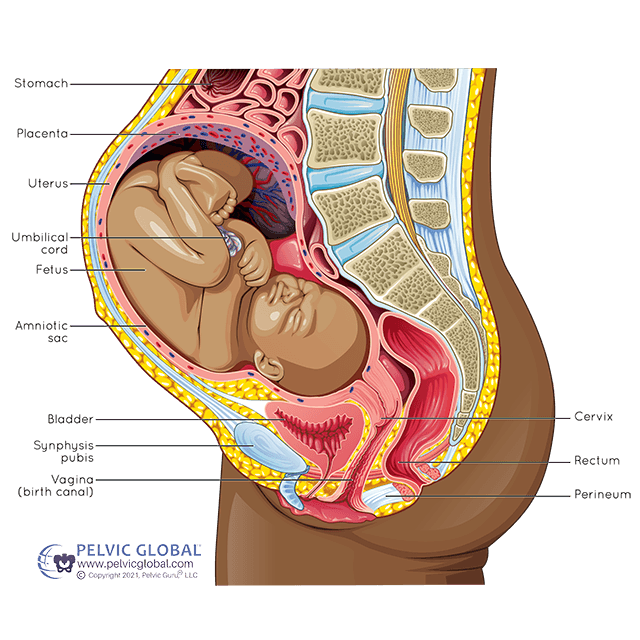Curious about what happens to your pelvic floor during pregnancy? Asking yourself how to prepare your pelvic floor for birth? Or maybe you’re looking for tips on how to heal postpartum? This article looks at the most commonly asked questions about the effect of pregnancy on the pelvic floor. We also offer you tips for how to prepare and recover.
There are lots of things going on that can make for a weaker pelvic floor in pregnancy and postpartum. This may be the normal changes occurring in pregnancy and simply affect some moms more than others. Some may be due to circumstances that arise in the process of giving birth or from certain birthing procedures. There are even emotional changes that can play into the strength of your pelvic floor.
What Happens to Your Pelvic Floor During Pregnancy (and after birth)
When you think about what they have to support, it’s not surprising they need exercising to stay strong!
Three major organs of your pelvic region: your bladder, uterus and bowel are literally held in by your pelvic floor muscles.

As your uterus does its incredible expansion and you grow a baby in there (or a few of them at once), it is obviously going to put some added strain on the soft tissue in your pelvic floor. They are responsible for helping hold up your organs normally, and have the added responsibility of supporting the weight of your growing baby, too.
You may start noticing that it’s harder to hold in your pee during pregnancy, especially in the last trimester. That’s from the added pressure of a growing feotus on your pelvic floor muscles and bladder. Constipation is another common issue in pregnancy for the same reason.
You may also notice an increase in hip pain, ligament pain around your groin, and feeling unstable as you walk from the combination of normal loosening hormones and pelvic floor strain in late pregnancy.
Three major organs, the weight of a baby, and the massive pressure of possibly hours of pushing down hard during labor. A c-section may mean you avoided the pushing or any tearing, but the weight borne throughout pregnancy will still very much apply.
Is Pelvic Floor Therapy Safe During Pregnancy?
Yes! Remember it’s not just about squeezing, squeezing, squeezing. Pelvic floor exercises include stretching and releasing as well as working on tone.
This is especially important for preparing for birth. Having an overly tight pelvic floor can work against you when it comes time to push.
If this sounds a bit like Goldilocks, it can be. Listen to your own body as it shifts and changes through pregnancy, working on firming and stretching as it seems fit.
Some good pelvic floor exercises in pregnancy are:
- Stretching
- Yoga
- Deep squats
- Walking
- Breath work
- Kegels
- Alignment and core exercises
For more on how to do pelvic floor exercises read the article in our pelvic floor resources.
The Benefits of a Healthy Pelvic Floor for Birth
In both vaginal and cesarean births, the pelvic floor undergoes a lot of strain.
Labor is an intensive process and lengthy births — especially longer active pushing stages — can cause added strain on your muscles. You can let your baby descend without active pushing can help lessen the wear and tear on your pelvic floor. Same with slow and controlled pushing after your baby crowns. Some providers are more open to supporting this, so make sure to talk with them about your desire to have a pushing stage in line with your goals of keeping as strong of a pelvic floor as possible.
Cesarean births require making a large incision in your abdominal muscles. Your pelvic floor after a c-section may have a weaker strength for healing. The added rest required with cesarean recovery can also delay pelvic floor recovery.
Other operative birth methods (like forceps and vacuum-assisted births) can contribute to a weakened pelvic floor in birth also. Both forms of assisted birth can often require an episiotomy (a surgical cut on your perineum) or more intensive tearing.
Having a stronger pelvic floor going into birth can help reduce the potential strain on your pelvic floor muscles in more complicated births and help shorten recovery. So if you’re asking whether you can do pelvic floor therapy while pregnant, the answer is yes!
Pelvic floor recovery after birth: Take control over your own
The good news is, even though pregnancy will change your pelvic floor alone, and most births will put further strain on these muscles and tendons, it doesn’t mean you’re forever damaged!
Being a mum who leaks pee when you sneeze or jump is part of our normal conversation nowadays, but it’s not normal. It’s more a result of overly invasive birthing care with a lack of attention paid to supportive postpartum recovery than anything else. You can regain control with your pelvic floor recovery after birth.
There’s no real time limit on that recovery, either. If you’re still struggling with a weakened pelvic floor years after birth, you can still work to strengthen, stretch, and tone those muscles long after birth.
Recognizing Common Symptoms of Pelvic Floor Issues After Birth
When can you tell something is wrong? Well, here are some common symptoms of pelvic floor dysfunction after giving birth:
- pain during postpartum sex
- tailbone pain
- leaking urine or feces
- cramping or spasming vaginal muscles
- vaginal or anal prolapse
Taking Charge of Your Pelvic Floor Health: What You Can Do
Whether you’re prepping for birth or in postpartum recovery, there are lots of things you can learn about pelvic floor health and do to maintain it.
The MUTU program is proven to help with pelvic floor health and function at ALL stages of motherhood. You get 10 days completely free to see if you like it.

If it’s an option for you, it’s a great idea to set up an appointment with a pelvic floor physical therapist. They can help give you more useful tips, help start a diagnosis if you are experiencing issues already, and make referrals when needed.
Last, don’t forget to consider the mental wellbeing aspect of pelvic floor health. This is often left out of the conversation, but is essential for many.










One comment